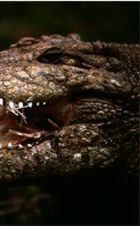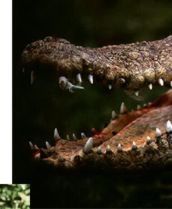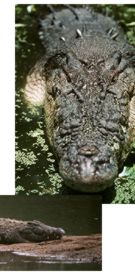
When you think of the Everglades, you think of alligators and crocodiles.



![]() In Florida's Everglades,
ten-foot-long alligators bask in the sun and the steamy heat, keeping
an eye open for their next big catch.At night the swamp resounds with
their roars and the ground trembles as they act out their mating rituals.
In Florida's Everglades,
ten-foot-long alligators bask in the sun and the steamy heat, keeping
an eye open for their next big catch.At night the swamp resounds with
their roars and the ground trembles as they act out their mating rituals.
![]() But alligators perform an important
function in the Everglades. Studies of the alligator indicate that they
contribute much to the preservation of plant and animal life.
But alligators perform an important
function in the Everglades. Studies of the alligator indicate that they
contribute much to the preservation of plant and animal life.

![]() Alligators keep the
bony-scaled spotted garfish in check. Without control on the gar population,
these fish would eat up all the valuable bass and bream, as well as other
game fish.
Alligators keep the
bony-scaled spotted garfish in check. Without control on the gar population,
these fish would eat up all the valuable bass and bream, as well as other
game fish.

![]() The alligator contributes
toward the preservation of living things by digging basinlike holes in
areas where the water table fluctuates greatly. In the Everglades, these
"gator holes" constitute the deepest pools. During periods of drought
they are the last to dry up and so provide a refuge for various fish,
amphibians and reptiles. Once the drought passes, the creature life preserved
in the "gator holes" can begin to multiply. These holes also supply food
and water for birds and mammals.
The alligator contributes
toward the preservation of living things by digging basinlike holes in
areas where the water table fluctuates greatly. In the Everglades, these
"gator holes" constitute the deepest pools. During periods of drought
they are the last to dry up and so provide a refuge for various fish,
amphibians and reptiles. Once the drought passes, the creature life preserved
in the "gator holes" can begin to multiply. These holes also supply food
and water for birds and mammals.

